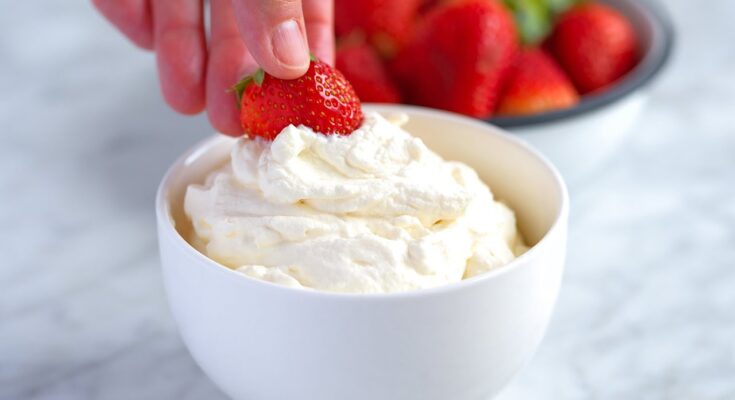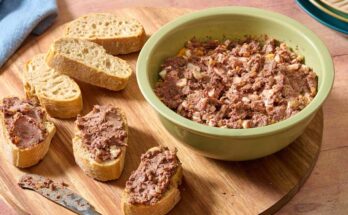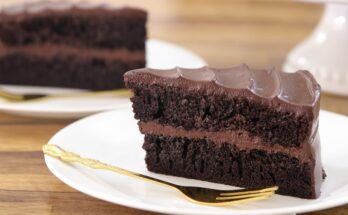Heavy Cream Recipe: Heavy cream is that luxurious, velvety ingredient that turns simple dishes into something extraordinary. Known also as heavy whipping cream, it’s the high-fat part of milk that rises to the top. With a fat content of around 36-40%, heavy cream is thicker than regular milk and perfect for recipes that need richness and body. Whether you’re whipping it for desserts or stirring it into savory sauces, it’s a kitchen essential. If you’ve ever wondered what makes creamy pastas or silky soups so comforting, chances are it’s the magic of heavy cream doing the trick.
Not only is it versatile, but it also adds a smooth texture and a subtle richness that’s hard to beat. And the best part? You don’t always have to rush to the store for it. With just a couple of ingredients, you can whip up your own heavy cream right at home. It’s simple, economical, and tastes just as good—sometimes even better!
Uses of Heavy Cream in Cooking and Baking
Heavy cream is the unsung hero of both sweet and savory recipes. It’s used to create luscious whipped toppings, rich ganache, velvety soups, creamy sauces, custards, and even ice creams. In baking, it helps make pastries flakier, cakes moister, and frostings silkier. Love Alfredo sauce? Heavy cream’s what gives it that silky texture. Fond of chocolate mousse? You can’t make that without a good dollop of whipped cream.
Beyond traditional uses, heavy cream can also be a lifesaver in everyday cooking. Add it to mashed potatoes for extra richness or drizzle a little into your scrambled eggs for a softer texture. It’s also fantastic in your morning coffee, giving it a creamy depth without needing sugar.
Ingredients Needed for Homemade Heavy Cream
Essential Ingredients
To make a basic homemade heavy cream, you only need two ingredients:
- Whole milk (preferably high-fat, organic if possible)
- Unsalted butter (real dairy, not margarine)
The combination of milk and melted butter mimics the high fat content of store-bought heavy cream. For every 1 cup of heavy cream needed, use:
- ¾ cup of whole milk
- ¼ cup of melted unsalted butter
These proportions provide the fat ratio similar to commercial heavy cream, making it a perfect substitute in most recipes.
Optional Additions for Texture and Flavor
Want to enhance your homemade version? Here are some optional ingredients:
- Powdered milk: Adds body and a slightly richer flavor.
- Cornstarch: Helps thicken the mixture slightly if using lower-fat milk.
- Vanilla extract: Just a drop can improve the taste for sweet applications.
- A pinch of salt: Brings out the flavor for savory uses.
While these extras aren’t necessary, they can bring your homemade cream a little closer to the real deal depending on what you’re making.
Equipment You’ll Need
Basic Kitchen Tools
You don’t need fancy gadgets to make heavy cream, but having the right tools helps a lot. Here’s what you should gather:
- Measuring cups and spoons: For accurate ratios.
- Mixing bowl: Medium size should suffice.
- Whisk or spoon: For combining ingredients thoroughly.
- Microwave or stovetop: To melt the butter safely.
That’s pretty much all you need. Simplicity is part of what makes this recipe so beginner-friendly.
Optional Gadgets for Better Consistency
If you want to go the extra mile, consider using:
- Blender or immersion blender: For a super smooth texture.
- Electric mixer: If you plan to whip the cream later.
- Thermometer: Helps ensure the butter isn’t too hot when combining with milk.
While these aren’t necessary, they can definitely help you achieve a more consistent result, especially if you’re making a larger batch or aiming for precise culinary perfection.
Step-by-Step Guide to Making Heavy Cream
Step 1: Choose the Right Ingredients
Start by choosing high-quality milk and butter. The higher the fat content in your milk, the better the result. Organic, full-fat milk and fresh, unsalted butter make the richest, creamiest homemade version. Avoid margarine or low-fat milk—they just don’t have the richness you’re looking for.
Also, ensure your butter is not overly hot. If it’s too warm when mixing, it can separate from the milk rather than blend smoothly.
Step 2: Measure the Ratios Properly
Precision matters here. Use ¼ cup of melted butter for every ¾ cup of milk to make 1 cup of heavy cream. This ratio creates a fat percentage close to commercial heavy cream.
Want a thicker consistency? Try adjusting slightly to 1/3 cup butter and 2/3 cup milk.
Mixing in a tablespoon of cornstarch per cup can also thicken the final mixture, especially if your milk is on the lighter side.
Step 3: Combine and Mix Thoroughly
Once your butter is melted (but not hot), slowly pour it into the milk. You want to pour the butter in a thin stream while whisking constantly. This helps the fat disperse evenly and prevents the mixture from separating.
You can whisk by hand, but for better results, use a hand mixer or an immersion blender. Blend on low to medium speed until the mixture looks smooth and cohesive. You’re not trying to whip it—just emulsify the fat and liquid together. If it separates a little, don’t worry. A quick blend will usually bring it back together.
If you’re using optional thickeners like cornstarch or powdered milk, now is the time to add them. Dissolve the cornstarch in a tablespoon of warm milk before mixing it in to avoid clumps. This helps your homemade heavy cream hold its shape better in recipes, especially when used for baking or whipping.
Step 4: Chill and Store Properly
Once your heavy cream is blended, it’s crucial to chill it. Place it in an airtight container or a clean glass jar and refrigerate it for at least an hour. This helps the mixture thicken and the flavors meld together. For the best results, use your homemade heavy cream within 3 to 4 days.
If you plan to whip it, make sure it’s very cold—this helps the cream hold its peaks better. Just like store-bought cream, the colder it is, the easier it whips.
Don’t leave it out at room temperature for long periods. Because it contains dairy, it can spoil quickly if not stored properly. Always use clean utensils when scooping it out to avoid contamination.
If you notice separation after refrigeration, simply stir or shake the container gently. It should come back together easily, especially if you used full-fat ingredients.
Tips for Perfect Homemade Heavy Cream
Troubleshooting Common Issues
Let’s face it—homemade versions don’t always go perfectly the first time. Here are some common problems and how to fix them:
- Cream too thin? Try adding a teaspoon of cornstarch or a tablespoon of powdered milk next time.
- Separation? Blend again or mix vigorously. Ensure your butter wasn’t too hot when you added it.
- Not whipping well? Make sure the cream is chilled thoroughly and use a cold bowl and beaters when whipping.
- Too greasy? This can happen if too much butter is used. Stick to the recommended ¾ milk to ¼ butter ratio unless you’re aiming for extra richness.
These small adjustments can make a big difference, especially if you’re planning to use the cream for delicate desserts or sauces.
How to Adjust Thickness
The texture of your heavy cream depends largely on the fat content. To adjust the thickness:
- For thicker cream: Reduce the milk slightly and increase the butter. A 2/3 cup milk to 1/3 cup butter ratio makes for a creamier blend.
- For lighter cream: Use 2% milk instead of whole milk, but understand it won’t whip or thicken as well.
Another trick? Let the cream chill longer. Cold temperatures naturally thicken the mixture and improve consistency. If using cornstarch or powdered milk, give it time to hydrate fully during refrigeration—usually an hour or more.
Some people even add a splash of cream cheese or mascarpone for ultra-rich cream in recipes like tiramisu or creamy pasta dishes.
FAQs about Heavy Cream Recipe
1. Can I make heavy cream at home?
Yes, you can make a simple heavy cream substitute by mixing whole milk with melted butter. For every 1 cup of heavy cream needed, combine ¾ cup of milk with ¼ cup of melted unsalted butter.
2. What’s the difference between heavy cream and whipping cream?
The main difference lies in fat content. Heavy cream contains about 36% fat, making it richer and better for thickening sauces, while whipping cream has around 30% fat and is ideal for light, fluffy toppings.
3. Can I use heavy cream in place of milk in recipes?
Yes, but keep in mind that heavy cream is much thicker and richer. You may need to dilute it with water (equal parts) to get a milk-like consistency.
4. Is heavy cream the same as double cream?
Not quite. Double cream, commonly used in the UK, has a higher fat content (about 48%) than heavy cream. It’s richer and thicker but can be used similarly in recipes with slight adjustments.
5. How long does homemade heavy cream last?
Homemade heavy cream substitute should be used within 2–3 days and kept refrigerated in an airtight container for freshness.
6. Can I whip homemade heavy cream?
If you’re using a homemade version with milk and butter, it typically won’t whip well due to lower fat content. For whipped cream, a store-bought heavy cream or high-fat substitute is more reliable.
7. What are dairy-free alternatives to heavy cream?
Popular dairy-free options include coconut cream, cashew cream, and soy or almond milk combined with oil or thickener, depending on the recipe.
8. Can I freeze heavy cream?
Yes, you can freeze heavy cream for up to 2 months. Just note that after thawing, it may separate—whisking or blending can help restore the texture.
Conclusion
The best part is how adaptable it is. Want a thicker consistency? Adjust the butter. Need it dairy-free? There are plant-based alternatives too. It’s all about understanding the components and making them work for you. With a little practice, you’ll be creating a batch of homemade heavy cream with your eyes closed.
So next time your recipe calls for heavy cream, don’t panic if the fridge is empty. You now have a reliable, step-by-step method to make your own. It’s fresh, customizable, and incredibly satisfying. Happy cooking!



